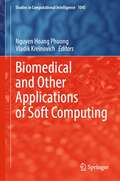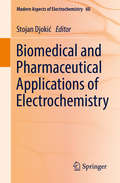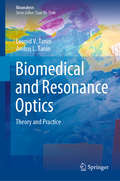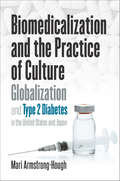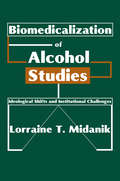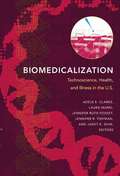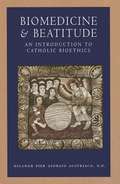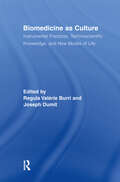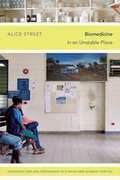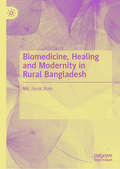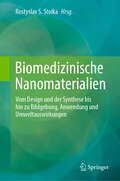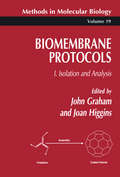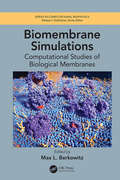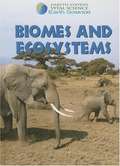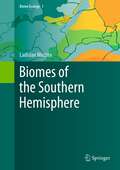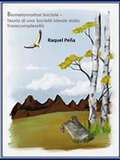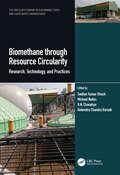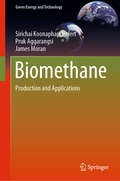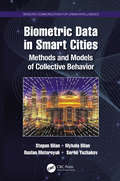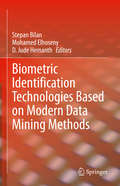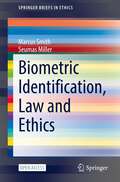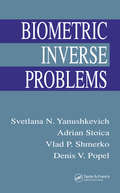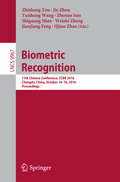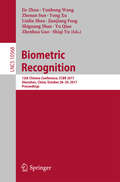- Table View
- List View
Biomedical and Other Applications of Soft Computing (Studies in Computational Intelligence #1045)
by Vladik Kreinovich Nguyen Hoang PhuongThis book describes current and potential use of artificial intelligence and computational intelligence techniques in biomedicine and other application areas. Medical applications range from general diagnostics to processing of X-ray images to e-medicine-related privacy issues. Medical community understandably prefers methods that have been successful other on other application areas, where possible mistakes are not that critical. This book describes many promising methods related to deep learning, fuzzy techniques, knowledge graphs, and quantum computing. It also describes the results of testing these new methods in communication networks, education, environmental studies, food industry, retail industry, transportation engineering, and many other areas. This book helps practitioners and researchers to learn more about computational intelligence methods and their biomedical applications—and to further develop this important research direction.
Biomedical and Pharmaceutical Applications of Electrochemistry (Modern Aspects of Electrochemistry #60)
by Stojan DjokićThis volume of Modern Aspects of Electrochemistry reviews the latest developments in electrochemical science and technology related to biomedical and pharmaceutical applications. In particular, this book discusses electrochemical applications to medical devices, implants, antimicrobially active materials, and drug delivery systems.
Biomedical and Resonance Optics: Theory and Practice (Bioanalysis #11)
by Leonid V. Tanin Andrei L. TaninThis book discusses fundamentally new biomedical imaging methods, such as holography, holographic and resonant interferometry, and speckle optics. It focuses on the development of holographic interference microscopy and its use in the study of phase objects such as nerve and muscle fibers subjected to the influence of laser radiation, magnetic fields, and hyperbaric conditions. The book shows how the myelin sheath and even the axon itself exhibit waveguide properties, enabling a fresh new look at the mechanisms of information transmission in the human body. The book presents theoretically and experimentally tested holographic and speckle-optical methods and devices used for investigating complex, diffusely scattering surfaces such as skin and muscle tissue. Additionally, it gives broad discussion of the authors’ own original fundamental and applied research dedicated to helping physicians introduce new contact-less methods of diagnosis and treatment of diseases of the cardiovascular and neuromuscular systems into medical practice. The book is aimed at a broad spectrum of scientific specialists in the fields of speckle optics, holography, laser physics, morphology and cytochemistry, as well as medical professionals such as physiologists, neuropathologists, neurosurgeons, cardiologists and dentists.
Biomedicalization and the Practice of Culture: Globalization and Type 2 Diabetes in the United States and Japan (Studies in Social Medicine)
by Mari Armstrong-HoughOver the last twenty years, type 2 diabetes skyrocketed to the forefront of global public health concern. In this book, Mari Armstrong-Hough examines the rise in and response to the disease in two societies: the United States and Japan. Both societies have faced rising rates of diabetes, but their social and biomedical responses to its ascendance have diverged. To explain the emergence of these distinctive strategies, Armstrong-Hough argues that physicians act not only on increasingly globalized professional standards but also on local knowledge, explanatory models, and cultural toolkits. As a result, strategies for clinical management diverge sharply from one country to another. Armstrong-Hough demonstrates how distinctive practices endure in the midst of intensifying biomedicalization, both on the part of patients and on the part of physicians, and how these differences grow from broader cultural narratives about diabetes in each setting.
Biomedicalization of Alcohol Studies: Ideological Shifts and Institutional Challenges
by Lorraine MidanikBiomedicalization is seen as the natural outgrowth of continued scientific progress--a movement towards improving the quality and quantity of life through scientific inquiries using biomedical perspectives and methods. This approach carries with it the assumption that with "proper" risk assessment, detection, and treatment, our lives can be lengthened, improved, and indeed more fulfilling. Yet critics question biomedicalization's ability to deliver. There is concern about how biomedicalization can change our traditional concepts of health as we discover more conditions for which we are at risk, and health maintenance is seen as the responsibility of the individual.The purpose of the book is to describe, assess, and critique biomedicalization and its influence as a larger social trend on the health field and specifically in the area of alcohol research, policy, and programs. Chapter 1 gives a broad overview of biomedicalization. Chapter 2 lays the groundwork for a historical understanding of how medicalization and biomeidcalization have developed and are expressed in diverse fields such as aging, psychiatry/mental health, and women's health. Chapter 3 focuses in-depth on alcoholism and assesses the development and assumptions underlying the two movements that have greatly influenced the substance abuse field: the medicalization of deviance and the growth of the disease model of alcoholism. Chapter 4 discusses the origins and development of the National Institute on Alcohol Abuse and Alcoholism (NIAAA) from its inception in 1970. Chapter 5 illustrates the growing biomedicalization that has occurred in the alcohol field prior to NIAAA's movement to the National Institute of Health (NIH). Chapter 6 assesses how Sweden has handled alcohol problems and currently funds alcohol research. Chapter 7 concludes with a rationale for an expanded discourse between social scientists and biomedical researchers working on social problems, particularly alcohol issues.This volume will stimulate discussion of the processes by which social problems, and specifically alcohol issues, are framed, managed, and studied. It will hold particular interest for researchers and students in the areas of alcohol studies, social science, and social welfare. Lorraine Midanik is a professor in the School of Social Welfare, University of California, Berkeley.
Biomedicalization: Technoscience, Health, And Illness In The U. S
by Laura Mamo Adele E. Clarke Janet K. Shim Jennifer Ruth Fosket Jennifer R. FishmanThe rise of Western scientific medicine fully established the medical sector of the U.S. political economy by the end of the Second World War, the first “social transformation of American medicine.” Then, in an ongoing process called medicalization, the jurisdiction of medicine began expanding, redefining certain areas once deemed moral, social, or legal problems (such as alcoholism, drug addiction, and obesity) as medical problems. The editors of this important collection argue that since the mid-1980s, dramatic, and especially technoscientific, changes in the constitution, organization, and practices of contemporary biomedicine have coalesced into biomedicalization, the second major transformation of American medicine. This volume offers in-depth analyses and case studies along with the groundbreaking essay in which the editors first elaborated their theory of biomedicalization. Contributors. Natalie Boero, Adele E. Clarke, Jennifer R. Fishman, Jennifer Ruth Fosket, Kelly Joyce, Jonathan Kahn, Laura Mamo, Jackie Orr, Elianne Riska, Janet K. Shim, Sara Shostak
Biomedicine And Beatitude: An Introduction to Catholic Bioethics
by Nicanor Pier Giorgio Austriaco<P>How are the patient, the physician, the nurse, and the scientist called to grow in holiness in their particular vocations? This introductory text, written from within the Catholic moral tradition, narrates a bioethics that emphasises the pursuit of beatitude in the lives of those who are confronted by moral questions raised by biomedicine and the other life sciences. <P>The Catholic moral vision that informs this volume is rooted in the moral life described by the Lord Jesus Christ in his Sermon on the Mount. As Pope John Paul II taught in his moral encyclical, Veritatis splendour, we imitate Christ by seeking, with God's grace, to perfect ourselves through our actions and the virtues they engender. In this way, Catholic bioethics differs from other contemporary approaches to bioethics that focus on either the outcomes of human acts or the procedures that protect the autonomy of the human agent. <P>Besides ethical questions raised at the beginning and the end of life, Nicanor Austriaco, O.P., discusses the ethics of the clinical encounter, human procreation, organ donation and transplantation, and biomedical research. Finally, the text discusses the realities faced by citizens of faith living in a free and democratic society that is at the same time postmodern, secular, and liberal.
Biomedicine as Culture: Instrumental Practices, Technoscientific Knowledge, and New Modes of Life (Routledge Studies in Science, Technology and Society)
by Joseph Dumit Regula Valérie BurriThis volume offers interdisciplinary perspectives on contemporary biomedicine as a cultural practice. It brings together leading scholars from cultural anthropology, sociology, history, and science studies to conduct a critical dialogue on the culture(s) of biomedical practice, discussing its epistemic, material, and social implications. The essays look at the ways new biomedical knowledge is constructed within hospitals and academic settings and at how this knowledge changes perceptions, material arrangements, and social relations, not only within clinics and scientific communities, but especially once it is diffused into a broader cultural context.
Biomedicine in an Unstable Place: Infrastructure and Personhood in a Papua New Guinean Hospital
by Alice StreetBiomedicine in an Unstable Place is the story of people's struggle to make biomedicine work in a public hospital in Papua New Guinea. It is a story encompassing the history of hospital infrastructures as sites of colonial and postcolonial governance, the simultaneous production of Papua New Guinea as a site of global medical research and public health, and people's encounters with urban institutions and biomedical technologies. In Papua New Guinea, a century of state building has weakened already inadequate colonial infrastructures, and people experience the hospital as a space of institutional, medical, and ontological instability.In the hospital's clinics, biomedical practitioners struggle amid severe resource shortages to make the diseased body visible and knowable to the clinical gaze. That struggle is entangled with attempts by doctors, nurses, and patients to make themselves visible to external others--to kin, clinical experts, global scientists, politicians, and international development workers--as socially recognizable and valuable persons. Here hospital infrastructures emerge as relational technologies that are fundamentally fragile but also offer crucial opportunities for making people visible and knowable in new, unpredictable, and powerful ways.
Biomedicine, Healing and Modernity in Rural Bangladesh
by Md. Faruk ShahThis book provides an ethnographic account of the ways in which biomedicine, as a part of the modernization of healthcare, has been localized and established as the culturally dominant medical system in rural Bangladesh. Dr Faruk Shah offers an anthropological critique of biomedicine in rural Bangladesh that explains how the existing social inequalities and disparities in healthcare are intensified by the practices undertaken in biomedical health centres through the healthcare bureaucracy and local gendered politics. This work of villagers’ healthcare practices leads to a fascinating analysis of the local healthcare bureaucracy, corruption, structural violence, commodification of health, pharmaceutical promotional strategies and gender discrimination in population control. Shah argues that biomedicine has already achieved cultural authority and acceptability at almost all levels of the health sector in Bangladesh. However, in this system healthcare bureaucracy is shaped by social capital, power relations and kin networks, and corruption is a central element of daily care practices.
Biomedizinische Nanomaterialien: Vom Design und der Synthese bis hin zu Bildgebung, Anwendung und Umweltauswirkungen
by Rostyslav S. StoikaIn diesem Buch wird beschrieben, wie Nanomaterialien organischer und mineralischer Natur entworfen und synthetisiert werden können. Das Buch behandelt auch die Visualisierung der entwickelten Nanomaterialien und ihre Bioanwendungen und beschreibt die biomedizinischen Wirkungen und Umweltauswirkungen von Nanomaterialien.Es ist ein ideales Buch für Studenten der Biomedizin oder der Biowissenschaften sowie für Forscher und Fachleute in den Bereichen Medizin, Umweltschutz, Biotechnologie, Landwirtschaft und Lebensmittelindustrie. Dieses Buch befasst sich insbesondere mit den wichtigen Nanomaterialien und Nanobiotechnologien, die in diesen Bereichen der Biomedizin und der Biowissenschaften eingesetzt werden.
Biomembrane Protocols, I. Isolation and Analysis: I. Isolation and Analysis (Methods in Molecular Biology #19)
by Joan A. Higgins John M. GrahamExpert practitioners combine the traditional basic techniques of membrane isolation and analysis with modern advances in molecular biology, immunology, and clinical sciences to devise analytical techniques that are successful for expert and novice alike. The techniques are used in the isolation and compositional analysis of membranes and address animal, plant, and microbial cells. The topics covered in this first volume include the isolation of subcellular fractions, centrifugation, the extraction and quantitation of lipids, the separation and analysis of proteins, and the isolation and characterization of glycosylated molecules, glycoproteins, proteoglycans, and glycolipids.
Biomembrane Simulations: Computational Studies of Biological Membranes (Series in Computational Biophysics)
by Max L. BerkowitzDue to recent advancements in the development of numerical algorithms and computational hardware, computer simulations of biological membranes, often requiring use of substantial computational resources, are now reaching a mature stage. Since molecular processes in membranes occur on a multitude of spatial and time scales, molecular simulations of membranes can also serve as a testing ground for use of multi-scale simulation techniques. This book addresses some of the important issues related to understanding properties and behavior of model biological membranes and it Shows how simulations improve our understanding of biological membranes and makes connections with experimental results. Presents a careful discussion of the force fields used in the membrane simulations including detailed all-atom fields and coarse-grained fields. Presents a continuum description of membranes. Discusses a variety of issues such as influence of membrane surfaces on properties of water, interaction between membranes across water, nanoparticle permeation across the membrane, action of anesthetics and creation of inhomogeneous regions in membranes. Discusses important methodological issues when using simulations to examine phenomena such as pore creation and permeation across membranes. Discusses progress recently achieved in modeling bacterial membranes. It will be a valuable resource for graduate students, researchers and instructors in biochemistry, biophysics, pharmacology, physiology, and computational biology.
Biomes and Ecosystems
by Barbara J. DavisGareth Stevens Vital Science books are designed to help prepare students for NCLB science testing by reinforcing key concepts across the science curriculum. the six volumes in Earth Science use clear language and a variety of photographs, illustrations, and diagrams to help students understand the properties of rocks, soils, water, gases, and fossils. Weather, biomes and ecosystems, and earth's core and crust are also covered, making this a comprehensive and indispensable resource. image descriptions present
Biomes of North America: A Walk In The The Prairie
by Rebecca L. JohnsonTake a walk through the prairie. This biome of tall grass and open sky is teeming with life. How do the plants and animals of the prairie survive? As you travel through the prairie, watch closely to understand how each living creature is part of a circle of life.
Biomes of the Southern Hemisphere (Biome Ecology #1)
by Ladislav MucinaThis is the first comprehensive and critical evaluation of the biome (large-scale, functional biotic communities) patterns in the Southern Hemisphere. Revising the Heinrich Walter's zonobiome system for the Southern Hemisphere appeared as necessary because of the bioclimatic imbalance between the Hemispheres. This revision resulted in formulation of a new zonobiome system, considering the geographic peculiarities of both Hemispheres, hence creating a new, powerful tool of global nature-resource survey and conservation. The system has a potential to attract the interest of the global climate modeling community as the concept of biome (and associated hierarchical system) has a strong functional focus. All zonal biomes of the Southern Hemisphere are featured, and the major challenges we face in understanding their origins, structure, and functioning are discussed. The book contains a wealth of original data resulting from collation of bioclimatic data and vegetation mapping.
Biometamorfosi Sociale: Teoria di una società ideale dalla transcomplessità
by Raquel PeñaBiometamorfosi sociale di Raquel Peña. Teoria di una società ideale dalla transcomplessità. Siamo tutti capaci di trasformarci. Siamo tutti capaci di trasformarci. La società richiede che gli individui che la compongono prendano coscienza dell'importanza di essere persone migliori, sotto una concezione etica, morale e spirituale. Questo libro mostra i risultati di un'indagine condotta in un settore popolare venezuelano dalla percezione degli attori sociali e come la conoscenza che possiedono come fonte generatrice emerga dalle loro esperienze. È da questa ricerca che è nata la teoria: Biometamorfosi Sociale.
Biomethane through Resource Circularity: Research, Technology and Practices (The Circular Economy in Sustainable Solid and Liquid Waste Management)
by Sadhan Kumar Ghosh H. N. Chanakya Debendra Chandra Baruah Michael M. NellesBiomethane through resource circularity: Research, Technology and Practices is an invaluable resource for researchers, policy makers, implementers and PhD and Marsters level students in universities analyzing the present status, waste biomass including agro wastes, success in experimentation & commercial production, future needs and other relevant areas. While huge biomass is wasted by open burning, there is potential of energy generation that can be extracted from the biomass preventing GHG emission and creating business opportunities. Abundance and renewable bioenergy can contribute to a more secure, sustainable, and economically sound future through biomethanation process by selecting followings: Supply chain sustainability of clean energy sources Appropriate Anaerobic Digestion technology with different feedstock Processes Parameter Optimization and best fit conditions, Productivity, Purification of biogas and end use Economic feasibility as business case, Commercialization, generating employment and Revitalizing rural economies This book addresses most of the above issues in lucid manner by experts in the field from different countries which are helpful for the related stakeholders edited by experts in the field.
Biomethane: Production and Applications (Green Energy and Technology)
by James Moran Sirichai Koonaphapdeelert Pruk AggarangsiThis book discusses biomethane and the processes and applications downstream from biogas production. Biogas is a result of anaerobic digestion of agricultural or general household waste, such as manure, plants or food waste, and as such is considered a renewable energy source. Biomethane is a gas that results from any process that improves the quality of biogas by reducing the levels of carbon dioxide, hydrogen sulfide, moisture and other contaminant gases. Chemically, biomethane is the same as methane, and its name refers to the method of production rather than the content. Biomethane plants are generally found in locations with a low population density that are close to farms or food processing plants. In situations where there is no natural gas pipeline nearby, biomethane downstream applications can include storage, transportation, home heating, industrial use and distribution through small-scale local gas grids. This book discusses each of these applications and lists some of the design criteria as well as various issues relating to them.
Biometric Data in Smart Cities: Methods and Models of Collective Behavior (Sensors Communication for Urban Intelligence)
by Stepan Bilan Mykola Bilan Ruslan Motornyuk Serhii YuzhakovIn modern conditions of the development of intelligent systems to solve the problems of smart cities, more and more attention is paid to the construction of distributed intelligent systems, which, based on a network of sensors and specialized calculators, help residents and visitors of the city in real time to solve a whole range of complex problems that arise in an urban environment. In a smart city, much attention is paid to the processing of biometric information that comes from biometric sensors distributed throughout the city. Such biometric systems are multimodal and allow you to control the general condition of a person, and also help a person to move around the city and predict events within the city. This book describes methods for processing biometric information in a smart city environment. The theoretical foundations of building a biometric multisensor network, which allows you to create a unified urban biometric community, are considered. The theoretical foundations of the parallel shift technology and the Radon transformation on cellular automata with a hexagonal covering are presented. On the basis of these technologies, methods of biometric identification by gait parameters and the geometric shape of the auricle are described, which are effectively used in a smart city. A method for tracking dynamic changes in the state of a smart city in real time is considered. Models of behavior of colonies of living organisms, their formation, movement and interaction are described on the basis of the technology of cellular automata with active cells. Models of behavior of active cells in meeting with unwanted cells and models of combining and destruction of active cell colonies are also described. This book is intended for undergraduate, graduate students and specialists working and conducting research in the field of biometric information processing, as well as in the development and construction of distributed intelligent systems.
Biometric Identification Technologies Based on Modern Data Mining Methods
by Mohamed Elhoseny D. Jude Hemanth Stepan BilanThis book emphasizes recent advances in the creation of biometric identification systems for various applications in the field of human activity. The book displays the problems that arise in modern systems of biometric identification, as well as the level of development and prospects for the introduction of biometric technologies. The authors classify biometric technologies into two groups, distinguished according to the type of biometric characteristics used. The first group uses static biometric parameters: fingerprints, hand geometry, retina pattern, vein pattern on the finger, etc. The second group uses dynamic parameters for identification: the dynamics of the reproduction of a signature or a handwritten keyword, voice, gait, dynamics of work on the keyboard, etc. The directions of building information systems that use automatic personality identification based on the analysis of unique biometric characteristics of a person are discussed. The book is intended for professionals working and conducting research in the field of intelligent information processing, information security, and robotics and in the field of real-time identification systems. The book contains examples and problems/solutions throughout.
Biometric Identification, Law and Ethics (SpringerBriefs in Ethics)
by Seumas Miller Marcus SmithThis book is open access. This book undertakes a multifaceted and integrated examination of biometric identification, including the current state of the technology, how it is being used, the key ethical issues, and the implications for law and regulation. The five chapters examine the main forms of contemporary biometrics–fingerprint recognition, facial recognition and DNA identification– as well the integration of biometric data with other forms of personal data, analyses key ethical concepts in play, including privacy, individual autonomy, collective responsibility, and joint ownership rights, and proposes a raft of principles to guide the regulation of biometrics in liberal democracies.Biometric identification technology is developing rapidly and being implemented more widely, along with other forms of information technology. As products, services and communication moves online, digital identity and security is becoming more important. Biometric identification facilitates this transition. Citizens now use biometrics to access a smartphone or obtain a passport; law enforcement agencies use biometrics in association with CCTV to identify a terrorist in a crowd, or identify a suspect via their fingerprints or DNA; and companies use biometrics to identify their customers and employees. In some cases the use of biometrics is governed by law, in others the technology has developed and been implemented so quickly that, perhaps because it has been viewed as a valuable security enhancement, laws regulating its use have often not been updated to reflect new applications. However, the technology associated with biometrics raises significant ethical problems, including in relation to individual privacy, ownership of biometric data, dual use and, more generally, as is illustrated by the increasing use of biometrics in authoritarian states such as China, the potential for unregulated biometrics to undermine fundamental principles of liberal democracy. Resolving these ethical problems is a vital step towards more effective regulation.
Biometric Inverse Problems
by Svetlana N. Yanushkevich Vlad P. Shmerko Adrian Stoica Denis V. PopelTraditional methods of biometric analysis are unable to overcome the limitations of existing approaches, mainly due to the lack of standards for input data, privacy concerns involving use and storage of actual biometric data, and unacceptable accuracy. Exploring solutions to inverse problems in biometrics transcends such limits and allows rich analysis of biometric information and systems for improved performance and testing. Although some particular inverse problems appear in the literature, until now there has been no comprehensive reference for these problems. Biometric Inverse Problems provides the first comprehensive treatment of biometric data synthesis and modeling. This groundbreaking reference comprises eight self-contained chapters that cover the principles of biometric inverse problems; basics of data structure design; new automatic synthetic signature, fingerprint, and iris design; synthetic faces and DNA; and new tools for biometrics based on Voronoi diagrams. Based on the authors' vast experience in the field, the book authoritatively examines new approaches and methodologies in both direct and inverse biometrics, providing invaluable analytical and benchmarking tools. The authors include case studies, examples, and implementation codes for practical illustration of the methods. Loaded with approximately 200 figures, 60 problems, 50 MATLAB® code fragments, and 200 examples, Biometric Inverse Problems sets the standard for innovation and authority in biometric data synthesis, modeling, and analysis.
Biometric Recognition: 11th Chinese Conference, CCBR 2016, Chengdu, China, October 14-16, 2016, Proceedings (Lecture Notes in Computer Science #9967)
by Jie Zhou Shiguang Shan Zhisheng You Yunhong Wang Zhenan Sun Weishi Zheng Jianjiang Feng Qijun ZhaoThis book constitutes the refereed proceedings of the 11th Chinese Conference on Biometric Recognition, CCBR 2016, held in Chengdu, China, in October 2016. The 84 revised full papers presented in this book were carefully reviewed and selected from 138 submissions. The papers focus on Face Recognition and Analysis; Fingerprint, Palm-print and Vascular Biometrics; Iris and Ocular Biometrics; Behavioral Biometrics; Affective Computing; Feature Extraction and Classification Theory; Anti-Spoofing and Privacy; Surveillance; and DNA and Emerging Biometrics.
Biometric Recognition: 12th Chinese Conference, CCBR 2017, Shenzhen, China, October 28-29, 2017, Proceedings (Lecture Notes in Computer Science #10568)
by Jie Zhou Zhenhua Guo Yong Xu Shiguang Shan Yunhong Wang Zhenan Sun Jianjiang Feng Linlin Shen Yu Qiao Shiqi YuWith the increasing concerns on security breaches and transaction fraud, highly reliable and convenient personal verification and identification technologies are more and more requisite in our social activities and national services. Biometrics, used to recognize the identity of an individual, are gaining ever-growing popularity in an extensive array of governmental, military, forensic, and commercial security applications. ""Advanced Biometric Recognition Technologies: Discriminant Criterion and Fusion Applications"" focuses on two kinds of advanced biometric recognition technologies, biometric data discrimination and multi-biometrics, while systematically introducing recent research in developing effective biometric recognition technologies. Organized into three main sections, this cutting-edge book explores advanced biometric data discrimination technologies, describes tensor-based biometric data discrimination technologies, and develops the fundamental conception and categories of multi-biometrics technologies.
